
Saquib Salim
The Indian space program owes its success to Dr Vikram Sarabhai and Professor Satish Dhawan. Its first decade (1963 - 1973) is called the Vikram Sarabhai decade, for he gave of vision, dreams and hopes, and the next one can be referred to as the Satish Dhawan decade, during which the programs were consolidated.
Born on 25 September 1920 in Srinagar, Professor Dhawan received his mechanical engineering degree from the University of Punjab before moving to the USA for higher studies. He was appointed professor of the department of aeronautical engineering at the Indian Institute of Science (IISc) and later became its youngest director.
In 1972, Prof. Dhawan became the chairman of the Space Commission and ISRO while holding the positions of Secretary, Department of Space and Director of the IISc.
With this, the Indian space program took a big leap.
Satish Dhawan was a natural leader. His association with the Indian space program had started much before, as he taught scientists and engineers about aeronautics and rocket propulsion systems.
APJ Abdul Kalam often mentioned an incident about Dhawan to highlight his leadership.
Kalam wrote in his memoirs, “Two and a half decades ago, while I was working at ISRO…. I was given a task by Prof. Satish Dhawan, the then Chairman, ISRO, to develop the first satellite launch vehicle, SLV3, to put the ROHINI Satellite into orbit. This was one of the largest high-technology space programmes undertaken in 1973. The technology community, men and women, were geared up for this task. Thousands of scientists, engineers and technicians worked, resulting in the realisation of the first SLV-3 launch on August 10, 1979. SLV-3 took off in the early hours, and the first stage worked beautifully. But the mission could not achieve its objectives, as the control system in the 2nd stage malfunctioned.”
The SLV-3 crashed into the Bay of Bengal. The media was up in arms against the team leader, Abdul Kalam. The failure was a great setback to the nation.
“I could not believe,” Kalam said, “that so many years' worth of work had gone to waste. A flaw in the second-stage control system had nullified all our efforts…. I went away to my quarters and fell into a deep sleep. Sometime later, I felt a hand shaking me awake and someone calling my name. It was Professor Satish Dhawan. He had come looking for me, knowing how I would be feeling. He made me get up and took me to the cafeteria to eat. Like a friend, he watched over me and did not even bring up the failure in our conversation. We had to face the media too.. There, Professor Dhawan stood by me and answered the questions put by the media.”
“Prof. Dhawan took me to the press conference,” Kalam once told an audience, “And there he announced that he takes responsibility for not achieving the mission, even though I was the project director and the mission director.”
The problems were fixed, and the next launch date was scheduled for 18 July 1980. Kalam was the leader of the mission; Dhawan put his confidence in the same team.
It was a successful launch. Satellite ROHINI was put into orbit. Dhawan, who owned the failure, asked APJ Abdul Kalam to face the press and own up the success.
An emotional Kalam later said, “There are two lessons that have remained with me from this episode. The first is about having the resilience and courage to get up after a setback and carry on with the task. And the second is about the role of a leader in managing failure. A leader should give credit for success to the team, but own up and protect the team members if the mission fails. I learnt this important lesson in failure management not from any textbooks but by observing Professor Dhawan’s leadership style.”
The success made Kalam a national hero. Dhawan told Kalam that Prime Minister Indira Gandhi wanted to meet him. A shy Kalam was not sure if he was prepared to meet the PM. He wrote, “I was dressed in an ordinary shirt and on my feet were an old pair of sandals! When I said so to Professor Dhawan, what he replied has stayed with me always: ‘You are beautifully clothed in your success.’”
READ MORE: Artist-Poet G. R. Santosh was inspired by Kashmir's Shaivism, Tantra
The Indian Space Program has reached the moon and Mars now. APJ Abdul Kalam went on to become the President. India paid tribute to Dhawan by naming its Space Station after him.
